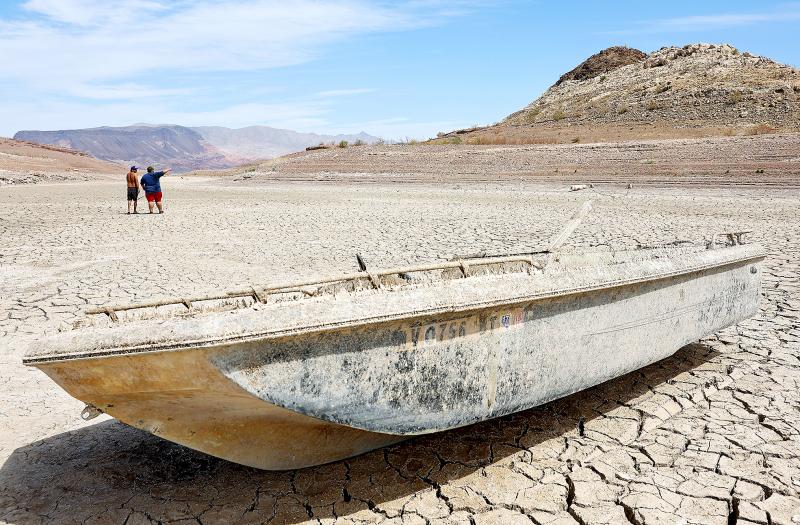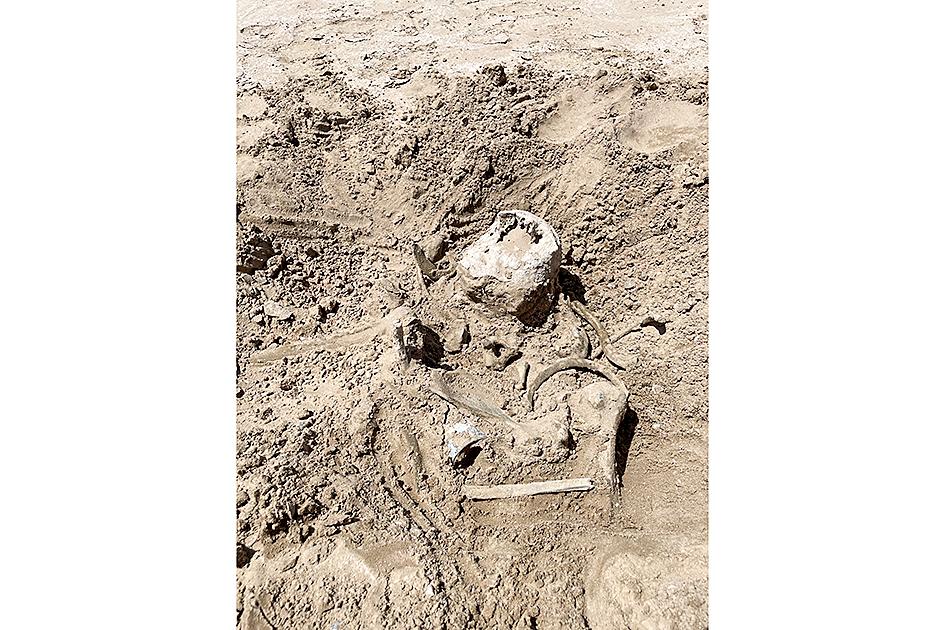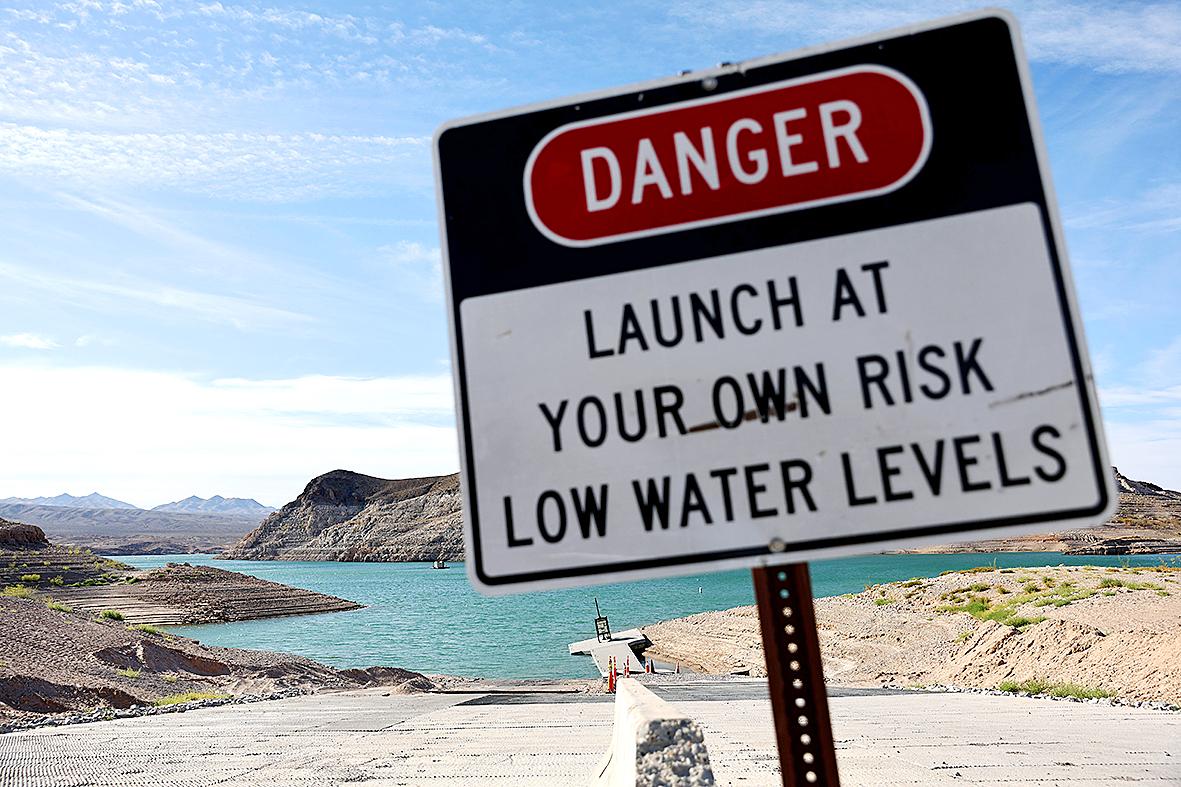Stories about long-departed Las Vegas organized crime figures are surfacing after a second set of unidentified human remains were revealed as the water level falls on drought-stricken Lake Mead.
The reservoir on the Colorado River is about a 30-minute drive from the mob-founded Las Vegas Strip.
“There’s no telling what we’ll find in Lake Mead,” former Las Vegas Mayor Oscar Goodman said Monday. “It’s not a bad place to dump a body.”

Photo: AFP
Goodman was a defense attorney who represented Mafia figures including ill-fated Anthony “Tony the Ant” Spilotro before serving three terms as a martini-toting mayor who made public appearances with a showgirl on each arm.
He declined to speculate about who might turn up in the vast reservoir formed by Hoover Dam between Nevada and Arizona.
“I’m relatively sure it was not Jimmy Hoffa,” he laughed, referring to the former labor boss who disappeared in 1975. But he added that a lot of his former clients seemed interested in “climate control” — mob speak for keeping the lake level up and bodies down in their watery graves.

Photo: AP
Instead, the world now has climate change, and as a result the surface of Lake Mead has dropped more than 52 meters since 1983. The lake that slakes the thirst of 40 million people in cities, farms and tribes across seven Southwestern states is down to about 30 percent of capacity.
“If the lake goes down much farther, it’s very possible we’re going to have some very interesting things surface,” said Michael Green, a University of Nevada, Las Vegas history professor whose father dealt blackjack for decades at casinos including the Stardust and Showboat.
“I wouldn’t bet the mortgage that we’re going to solve who killed Bugsy Siegel,” Green said, referring to the infamous gangster who opened the Flamingo casino in 1946 on what became the Strip. Siegel was shot dead in 1947 in Beverly Hills, California. His assassin has never been identified.

Photo: AFP
“But I would be willing to bet there are going to be a few more bodies,” Green said.
Last month, the dropping lake level exposed Las Vegas’ uppermost drinking water intake, forcing the regional water authority to switch to a deep-lake intake it completed in 2020 to continue to supply casinos, suburbs and 2.4 million residents and 40 million tourists per year.
The following weekend, boaters spotted the decomposed body of a man in a rusted barrel stuck in the mud of newly exposed shoreline.
The corpse has not been identified, but Las Vegas police say he had been shot, probably between the mid-1970s and early 1980s, according to the shoes found with him. The death is being investigated as a homicide.
A few days later, a second barrel was found by a KLAS-TV news crew, not far from the first. It was empty.
On Saturday, two sisters from the Las Vegas suburb of Henderson were paddle boarding on the lake near a former marina resort and noticed bones on a newly surfaced sand bar more than 14.5km from the barrels.
Lindsey Melvin, who took photos of their find, said they thought at first it was the skeleton of a bighorn sheep native to the region. A closer look revealed a human jaw with teeth. They called park rangers and the National Park Service confirmed in a statement that the bones were human.
There was no immediate evidence of foul play, Las Vegas police said Monday, and they are not investigating. A homicide probe would be opened if the Clark County coroner determines the death was suspicious, the department said in a statement.
Geoff Schumacher, vice president of The Mob Museum, said he expects “a lot” of whatever bodies lie beneath the lake’s surface will turn out to be drowning victims. But he said it’s clear whoever was in the barrel was a target.
Stuffing a body in a barrel has a “signature of a mob hit,” said Schumacher, whose museum is in a renovated historic downtown Las Vegas post office and federal building. It opened in 2012 as The National Museum of Organized Crime & Law Enforcement.
He and Green both cited the death of John “Handsome Johnny” Roselli, a mid-1950s Las Vegas mobster who disappeared in 1976. A few days later his body was found in a steel drum floating off the coast of Miami.
David Kohlmeier, a former police officer who now co-hosts a Las Vegas podcast and fledgling TV show called The Problem Solver Show, said Monday that after offering a US$5,000 reward last week for qualified divers to find barrels in the lake, he heard from people in San Diego and Florida willing to try.
But National Park Service officials said that’s not allowed and that there are hundreds of barrels in the depths, some dating to the construction of Hoover Dam in the 1930s.
Kohlmeier said he also heard from families of missing people and about cases like a man suspected of killing his mother and brother in 1987, a hotel employee who disappeared in 1992, and a father from Utah who vanished in the 1980s.
Green said the discoveries have people talking not only about mob hits, but about bringing relief and closure to grieving families.
“They’re going to think we’re going to solve every mob murder. In fact, we may see some,” he said. “But it’s also worth remembering that the mob did not like murders to take place in the Las Vegas area, because they did not like bad publicity going out under the Las Vegas dateline.”
Whatever story emerges about the body in the barrel, Goodman predicted it will add to the lore of a city that needed the creation of Lake Mead to sprout from the creosote bush-covered desert to become a marquee gambling mecca with a metro area home to about 2.25 million people.
“When I was the mayor, every time I went to a groundbreaking, I’d begin to shake for fear that somebody I may have run into over the years will be uncovered,” he joked.
Spilotro, Goodman’s one-time client, represented the Chicago mob in Las Vegas in the 1970s. He headed a crew dubbed the “Hole in the Wall” gang for drilling through walls to gain entry to homes and businesses. Spilotro’s body and the body of his brother, Michael Spilotro, were found in June 1986 by a farmer plowing a cornfield in northwest Indiana.
Tony the Ant served as the model for the character Nicky Santoro, portrayed by actor Joe Pesci, in Martin Scorsese’s 1995 movie Casino. Goodman played himself in the film.
“We have a very interesting background,” Goodman said. “It certainly adds to the mystique of Las Vegas.”

May 18 to May 24 Pastor Yang Hsu’s (楊煦) congregation was shocked upon seeing the land he chose to build his orphanage. It was surrounded by mountains on three sides, and the only way to access it was to cross a river by foot. The soil was poor due to runoff, and large rocks strewn across the plot prevented much from growing. In addition, there was no running water or electricity. But it was all Yang could afford. He and his Indigenous Atayal wife Lin Feng-ying (林鳳英) had already been caring for 24 orphans in their home, and they were in

On May 2, Chinese Nationalist Party (KMT) Chairman Eric Chu (朱立倫), at a meeting in support of Taipei city councilors at party headquarters, compared President William Lai (賴清德) to Hitler. Chu claimed that unlike any other democracy worldwide in history, no other leader was rooting out opposing parties like Lai and the Democratic Progressive Party (DPP). That his statements are wildly inaccurate was not the point. It was a rallying cry, not a history lesson. This was intentional to provoke the international diplomatic community into a response, which was promptly provided. Both the German and Israeli offices issued statements on Facebook

Even by the standards of Ukraine’s International Legion, which comprises volunteers from over 55 countries, Han has an unusual backstory. Born in Taichung, he grew up in Costa Rica — then one of Taiwan’s diplomatic allies — where a relative worked for the embassy. After attending an American international high school in San Jose, Costa Rica’s capital, Han — who prefers to use only his given name for OPSEC (operations security) reasons — moved to the US in his teens. He attended Penn State University before returning to Taiwan to work in the semiconductor industry in Kaohsiung, where he

President William Lai (賴清德) yesterday delivered an address marking the first anniversary of his presidency. In the speech, Lai affirmed Taiwan’s global role in technology, trade and security. He announced economic and national security initiatives, and emphasized democratic values and cross-party cooperation. The following is the full text of his speech: Yesterday, outside of Beida Elementary School in New Taipei City’s Sanxia District (三峽), there was a major traffic accident that, sadly, claimed several lives and resulted in multiple injuries. The Executive Yuan immediately formed a task force, and last night I personally visited the victims in hospital. Central government agencies and the